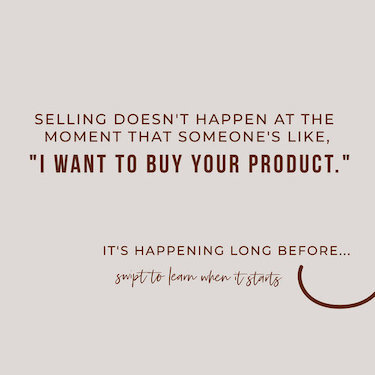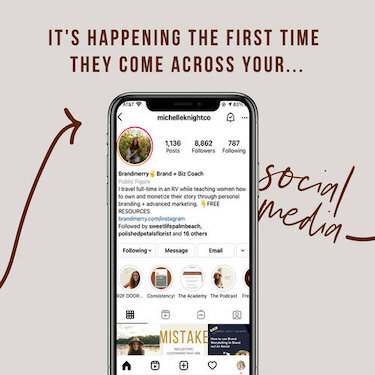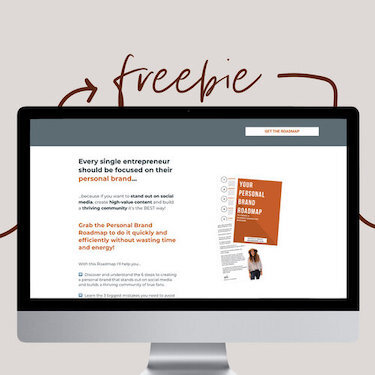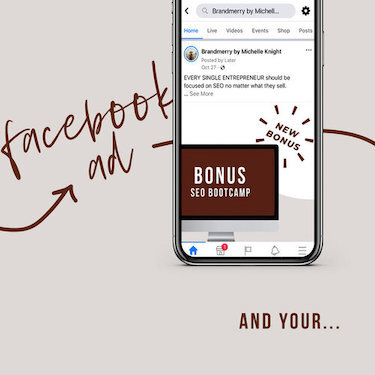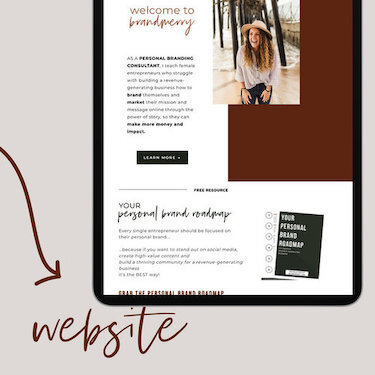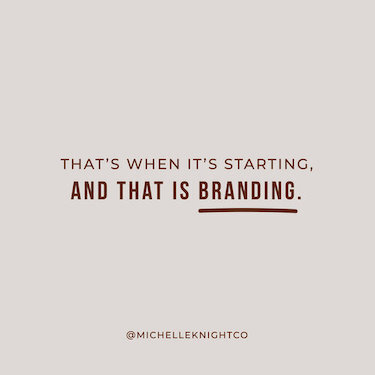What is Emotional Branding and How to Use It Effectively in 2021
What is Emotional Branding and How to Use It Effectively in 2021
BY MICHELLE KNIGHT
INTRO
I stumbled upon emotional branding when I started my business back in 2016.
I started my business with zero knowledge of building an online business. I had a background in public relations and communications, so you could say I knew a little bit about marketing, I knew a little bit about blogging, but I in no way knew how to actually brand myself online.
So I dove into the whole process, did it all wrong for months and then did it again. And it was during the do-it-again part, I discovered more about emotional branding and the power of storytelling.
I fell in love and watched over the next few months as it completely transformed my business. In just one year I went from $0 to a 6-figure cash business.
And everything I teach today through my programs is rooted in storytelling and emotional branding, two elements that fit hand in hand.
Because when we come from the place of, “I want my audience to feel X, Y, and Z,” it allows us to choose all of the things that we use in our marketing and our promotion in alignment with those feelings.
On today’s blog, I’m going to give you the tools to build a business around this same concept - emotional branding!
If you prefer to watch the content of this blog, you can scroll down and watch the full video.
What is Emotional Branding?
Emotional Branding is the art of communicating with your audience on a deeper, more personal level. It amplifies this idea of building relationships, which is what marketing truly is.
The end goal when marketing your business (which is just the art of amplifying your brand and attracting the right people) is relationship building.
And how do you know what types of content to create to build those relationships, if you don’t fully understand your audience?
This is why an integral piece of emotional branding and relationship marketing is knowing your audience.
By understanding your audience you can make decisions that connect deeply with their struggles, challenges and obstacles they’re facing and the goals and desires they are working towards and use that in your marketing.
And one more note on relationship marketing.
As consumers, we are bombarded with messages every day and we know as consumers that we're going to resonate with the ones that make us feel something, that stir something inside of us, that motivate us and make us feel a sense of belonging. This is the art of great branding.
Understanding how you want your audience to feel impacts the aesthetics of your brand; your logo, your font, your colors, your copy, the language that you're using in your copy, in your content, the stories that you're choosing, the messaging that you're using when you're on a live video, your website and even your products and services.
Emotional branding impacts every single aspect of your business.
The Benefits of Emotional Branding
A study from Harvard found that 90% of purchase decisions are made subconsciously.
This proves that the reason we buy is based not on the logistics we know about a product, but rather the interactions we’ve had that lead us to that brand and product/service. It comes down to the know, like and trust factor of a brand and how we feel the brand will solve our problem.
And as I mentioned in last week’s blog, when it comes to selling we always focus our energy on the sales conversation or the moment someone says, "I would like to buy your product," but that's not actually the buying process. The buying process is happening long before they decide to purchase or they put their credit card down, it's happening in those interactions with your brand.
So if the reason we invest in someone or something comes down to how that person, that product, that business, that brand ultimately makes us feel, wouldn’t you want to make sure you’re connecting on this level with your potential client?
I bet you do!
And it doesn’t stop there with the purchase. In fact, an area that many small business owners neglect is thinking about how they are continuing the art of emotional branding throughout the customer journey.
Yes, we need to start having real conversations about the customer journey and customer lifetime value.
When we start our businesses, it’s all about making money and with good reason. However, this mindset can keep us playing small as we continue to grow our business. Once we get those initial clients in the door what happens? How do we keep them engaged?
This is where emotional branding comes in because emotional branding has been proven to increase customer lifetime value and retention. When you build a deep connection with your audience from the start and continue to deliver on your mission, values and promise, you’re creating a fan for life.
And this is how you build a sustainable business!
Emotional Branding in Your Aesthetics
One of the first things we think of when it comes to branding is aesthetics. I get it, it’s so fun to think about your colors, fonts, logo, elements and more as a way to share your vision with the world.
But, the truth is small business owners and entrepreneurs are going about this completely backward!
One of the pieces in my signature branding course You! Branded, is determining the base of your brand through emotion and then using that to choose the aesthetics of your brand.
Visuals are some of the first parts of our brand that our audience sees and can be the difference between someone stopping mid scroll or not. We process visuals faster than text so understanding your brand and how to share that visually is essential.
How much more of an advantage would you have in your industry if these visuals were chosen with intention and focused on building an emotional connection with your audience? LIGHT YEARS ahead of others in your industry!
But, small business owners jump into their aesthetics too soon and without this groundwork. When you jump into the logo, color, those different things right away, you're going to sit there and you're gonna spin your wheels and it's gonna be really challenging, it's gonna take a lot of time, or you’re going to hire a designer that doesn’t fully grasp your vision.
But, when you start with understanding the emotional side of your brand and then choose those pieces, it happens way faster.
Choosing your fonts: Certain fonts really play up different emotions. Here’s a graphic sharing the different emotions associated with various types of fonts.
Let's say you’re a wedding photographer and you’re selecting a script font. If your ideal customer is an elegant bride and your package is for a high-end wedding with a price tag to match, you’re going to choose a completely different font and feel than a photographer who wants to attract a bohemian bride who wants to elope in the mountains.
Choosing fonts is a great way to make people feel something instantly without you having to say anything.
Choosing your colors. Color psychology is one of my favorite things to study and has been used in branding for decades.
Selecting your brand colors has to be about more than just, “I like this color, it’s my favorite color,” it has to be about your audience and how you want them to feel.
For instance, red is a power color, it signifies power, bold, and taking a stance.
Blue is very calming and yellow is joy.
You want to take this into consideration when choosing the colors of your brand!
Your elements. Things like your logo and photos are also heavily impacted by emotion. One of my favorite things to invest in is brand photography, in my opinion, it’s one of the best investments.
And when you go to a photographer and say, "These are my brand emotions, this is how I want someone to feel when they stumble on my social media feed, when they land on my website. Can you help me do that?" they are going to be so excited!
Having that information before hiring support will make sure that the end product is on brand and in alignment with what you want your audience to feel.
Choosing Your Emotions
When you're choosing your emotions I want you to think about aspirational branding.
It’s not about where your audience is now, but rather where your audience wants to be.
How does your audience want to feel?
What does your audience want to experience?
You can connect with them and where they are now through your copy and content, but that initial reaction, the visuals of your brand NEED to be what they are working towards, their desires.
Emotional Branding in Your Content
The aesthetics of your brand won’t change weekly, but your content will.
Once you set a strong foundation and choose your design elements you can rest easy knowing you don’t need to update those often. A refresh every once in a while is nice, but an overhaul is not necessary, especially when you follow my Build a Better Brand Method.
But that weekly content you’re creating will be ongoing and should also be rooted in the emotions of your brand. When it comes to writing content, I call this method emotionally-charged copy.
Emotionally-charged copy is the idea that you are connecting with your audience on a deep emotional level through your content, through your copy, and using language specifically for the.
This is why it’s crucial that you take the time to do the ideal client work.
When you are doing the ideal client work, you want to identify:
the current pain or struggles your audience is facing
the obstacles standing in their way
the pleasures they want to experience
their desires and goals that they have, both short-term and long-term
understanding what makes them excited and what they look forward to
what makes them frustrated and sad
Knowing these pieces and more will help you create copy that speaks clearly and emotionally to your audience.
At the end of the day, humans want to be seen, heard and understood and speaking to those pain and pleasure points through your content will do just that.
An example of emotionally-charged copy would be, "Have you ever felt like you worked all freaking day, staring at your to-do list, slowly checking off the boxes, but at the end of the day, you realize that you were no further along in building your business?"
This type of copy is much more specific and emotionally motivating than just saying, "Does it feel like you're constantly growing your business?"
When you can understand your audience and then speak to them on an emotional level, using language that is emotionally charged, it makes a difference, it could be the difference in an ad converting, it could be the difference in attracting the right person to your offer, it could be the difference between no money and $6,000 in your business.
COPY AND MESSAGING MATTER!
Brand Storytelling and Emotional Branding
Okay, let us wrap this up by talking about one final thing, my favorite thing, and that is storytelling and emotional branding.
These two things are like peanut butter and jelly, they're branding best friends.
This is what I’m obsessed with and teach all of my clients.
When we hear or read a story, we feel something inside, even if we haven't lived that exact same story, it's in the language, it's in the art of storytelling, and it’s happening inside our brains with the release of dopamine. This release makes stories 22x more memorable than content without storytelling aspects.
In addition to this awesome release of dopamine, storytelling helps with persuasion.
Aristotle stated that the three keys to persuasion are Ethos, Pathos and Logos. Take me back to college, am I right?!
And each of these pieces helps with persuading someone to take action, aka buy your product. Logos is the logistical side, which is important, but as we chatted above it’s not the reason people make a purchase.
Ethos and Pathos are where the money is at. Ethos is about showcasing your credibility and authority and Pathos is about empathy - both of these elements can be communicated beautifully through storytelling.
Through storytelling, you showcase authority by giving value to your audience. Understanding your audience, understanding what they need, giving them value through your storytelling, through your content, is important as a business owner.
By understanding your audience you can also use storytelling to show empathy, connecting to their pain, pleasures and desires. These can be stories from your life and journey, fictional stories that paint a picture of what is possible, and/or your client’s stories.
CONCLUSION
To recap, when it comes to emotional branding the first thing you need to do is understand how you want your audience to feel, then you need to choose the aesthetics that showcase that.
Then you use those key emotions and information from your ideal client research to build the visual representation of your brand, i.e. the aesthetics.
From there you begin to create the copy, those really, really emotionally charged messages on social media, via email, on Pinterest, on your blog, on video, wherever it is that you're showing up, you create that content for your audience.
And that’s the secret, if there’s a secret when it comes to being a business owner I’m convinced it’s the power of emotional branding. Yet, it’s underutilized by so many online small business owners.
As you head into 2021 and beyond, I encourage you to activate this emotional branding component, activate these storytelling pieces so that you can build your business and a thriving community of ideal customers.
A great place to start is by watching my free Build a Better Brand class here.
P.S. You’re invited to watch the Build a Better Brand Method class to learn how to build a brand built on an emotion that connects deeply with your audience. Sign up here.
Watch the full video training below. This video is part of my weekly show Mondays With Michelle at 4 pm CST on Facebook and Instagram.
- FREE GIFTS YOU'LL LOVE -
DISCOVER YOUR BRAND STORY IN UNDER 5 MINUTES
LEARN HOW TO WRITE AN ‘ABOUT ME’ PAGE THAT CONVERTS
MAP OUT 30 DAYS OF CONTENT IN UNDER AN HOUR
- READ THE LATEST POSTS -
MEET MICHELLE
Hey there, I'm Michelle Knight and I an online branding and marketing consultant for female entrepreneurs.
I believe in the power of storytelling and using that superpower to brand and market yourself online...oh and to set yourself free.
I'm obsessed with living a life of freedom, so much so, that my family and I now travel full-time while running my business from the road.
This blog serves as a home base for all things branding, marketing, content creation and more.


